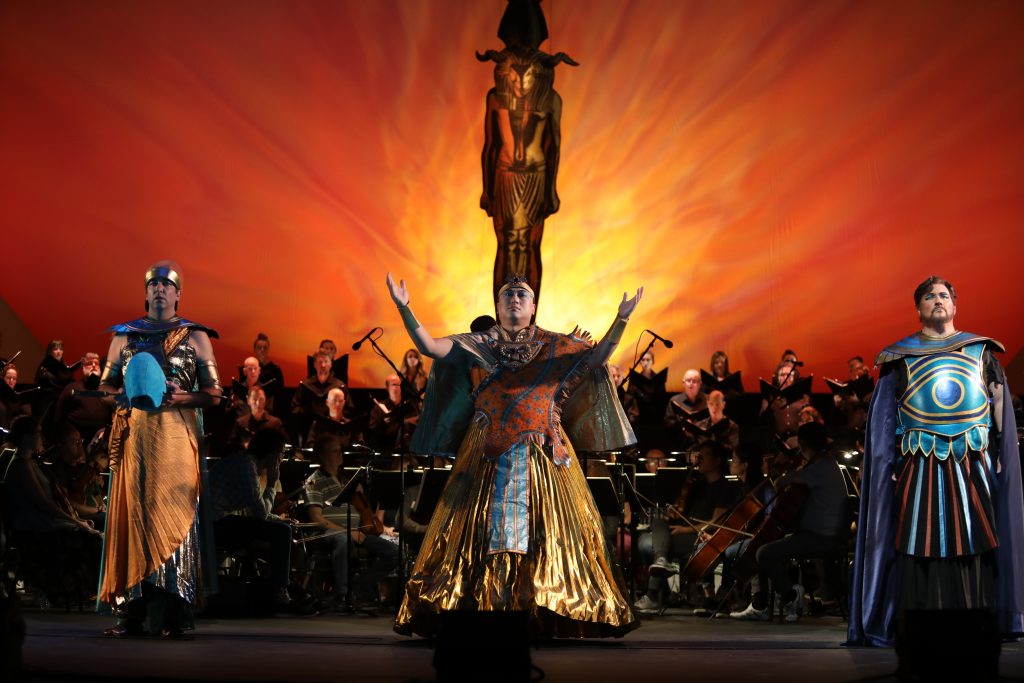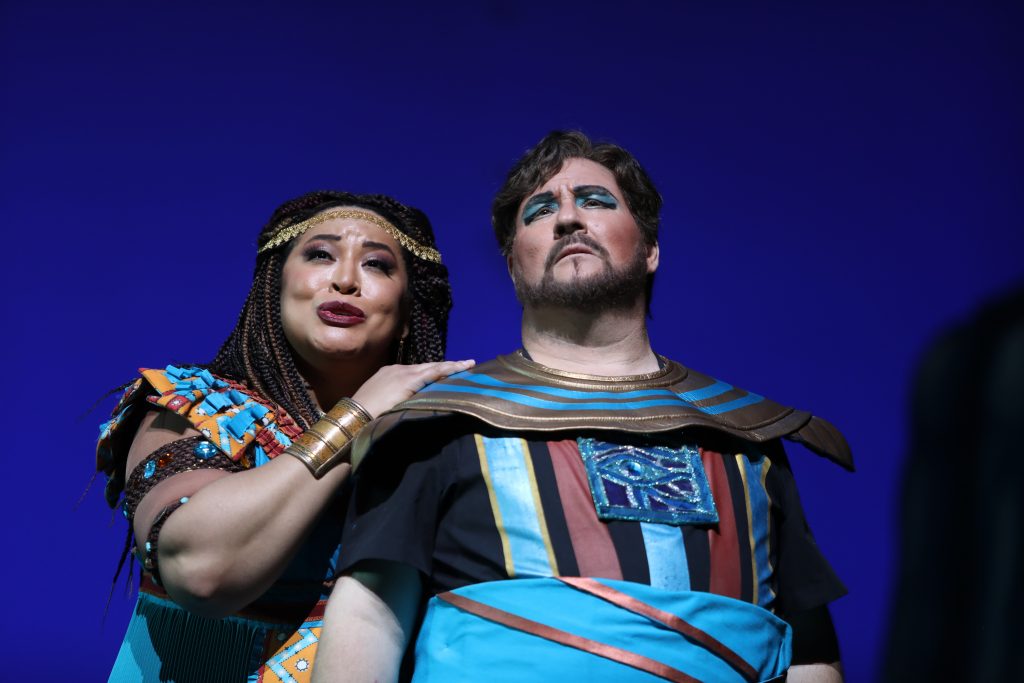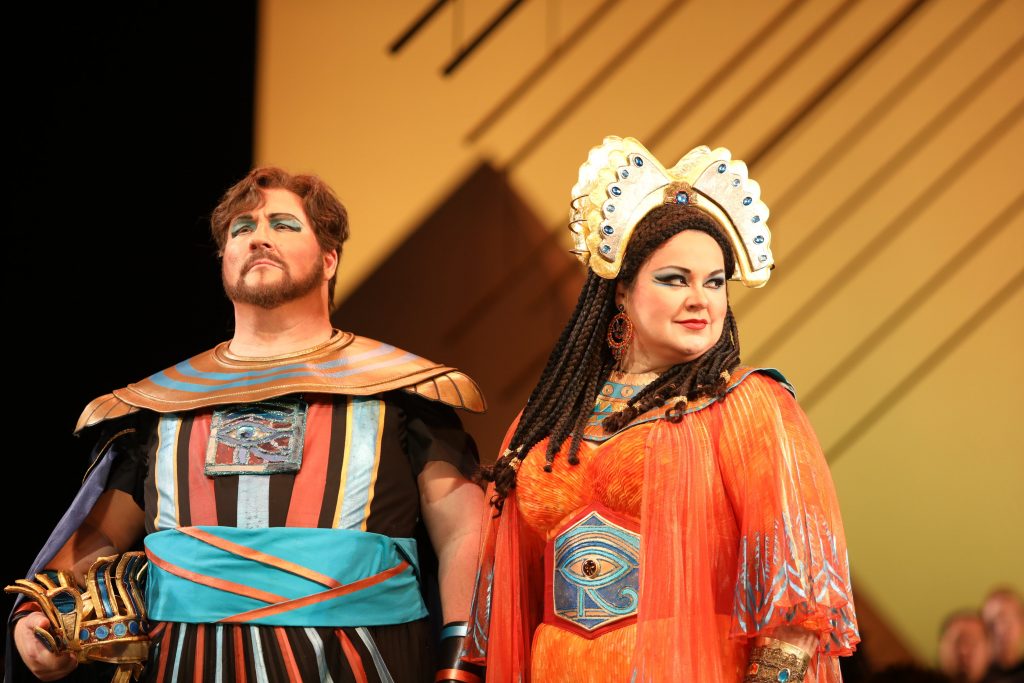Stellar Cast Leads San Diego Opera’s Unusual Presentation of Verdi’s ‘Aïda’
San Diego Opera opened its production of Verdi’s beloved grand opera Aïda Saturday at San Diego Civic Theatre with as winning a cast of Aïda singers as you will hear just about anywhere. The three principals—soprano Michelle Bradley as Aïda, tenor Carl Tanner as Radamès, and mezzo-soprano Olesya Petrova as Amneris—revealed attractive, powerful Verdi voices and never stinted on the emotional vibrancy we expect from this tabloid-worthy romantic triangle set in ancient Egypt.

Bernardo Bermudez, Simon Lim & Carl Tanner (left to right) [photo (c.) Edward Wilensky]

Michelle Bradley & Carl Tanner [photo (c.) Edward Wilensky]

Carl Tanner & Olesya Petrova [photo(c.) Edward Wilensky]
However, placing the Opera Chorus at the back of the stage, diminished their volume and sonic presence, even though this production’s chorus was larger than most of the company’s productions. When the San Diego Symphony used to perform in Civic Theatre—those years prior to moving to the Jacobs Music Center—we learned that it took a 100-member chorus seated behind the orchestra to balance the orchestra.

Nelson Martínez [photo (c.) Edward Wilensky]
Michelle Bradley’s performance of the title role left nothing to be desired. She gave us a proud, assertive Aïda capable of expressing the humiliation of her subjugation to the haughty Egyptian Princess Amneris, and Bradley’s ample, dramatic soprano voice contained just enough spinto shimmer to execute the wide range of vocal challenges Verdi gave this role. Olesya Petrova’s rich mezzo-soprano matched the breadth of Bradley’s vocal profile, and the Russian singer balanced her character’s jealousy of Aïda with heartfelt expressions of love for Radamès.
When Carl Tanner sang Calaf in San Diego Opera’s 2017 production of Puccini’s Turandot, I expressed a few reservations about his vocal performance. His Radamès, however, proved vocally compelling from the start, and as the evening progressed, his radiant tenor gave a depth and empathy to his character that eludes many tenors in this role.
Soprano Tasha Koontz gave a sterling account of the High Priestess’ solo in the choral anthem sung in the temple of Vulcan, and tenor Bernardo Bermudez’ Messenger communicated urgency and winning vocal presence.
Considering the limitations of this staging—no long staircases from which to make a stately entrance, no pillars to hide behind—Alan E. Hicks’ inventive direction kept his characters in motion and clarified their relationships. Chris Rynne’s subtly modulated lighting mitigated the austerity of this staging. Rhodes’ playful, vivid costumes saluted the Egyptian revival styles of the 1920s, and what could be used from Michael Yeargan’s scenic design helped define the space in minimalist fashion.
No doubt the opera staff and the board will be discussing the merits of using this type of theatrical concert staging again. May I suggest that it is a possible way to present a lesser-known opera, say Boito’s Mefistofele or Janáček’s Jenufa. For such operas, most audience members will not have memories of full productions they have experienced, memories that doggedly underscore what they are missing in a theatrical concert staging. But staging another beloved, frequently produced opera in this format may bring about audience disappointment that could be just a unfortunate to the company’s finances as staging a lavish grand opera.
San Diego Opera’s production of Giuseppe Verdi’s “Aïda” opened on October 19, 2019, in San Diego Civic Theatre and will be repeated there on October 22, 25, and 27, 2019.

Ken Herman, a classically trained pianist and organist, has covered music for the San Diego Union, the Los Angeles Times’ San Diego Edition, and for sandiego.com. He has won numerous awards, including first place for Live Performance and Opera Reviews in the 2017, the 2018, and the 2019 Excellence in Journalism Awards competition held by the San Diego Press Club. A Chicago native, he came to San Diego to pursue a graduate degree and stayed.Read more…



I could not disagree more with Mr. Herman’s final paragraph. For me – and everyone sitting around me – the absence of spectacle in this production made it finally possible to focus on Verdi’s glorious music. I hope San Diego Opera will continue to offer us productions that bring the focus back to the music, but still retain enough of the drama to feel that you’ve seen an opera performance. Bravo to SDO for this innovative offering.